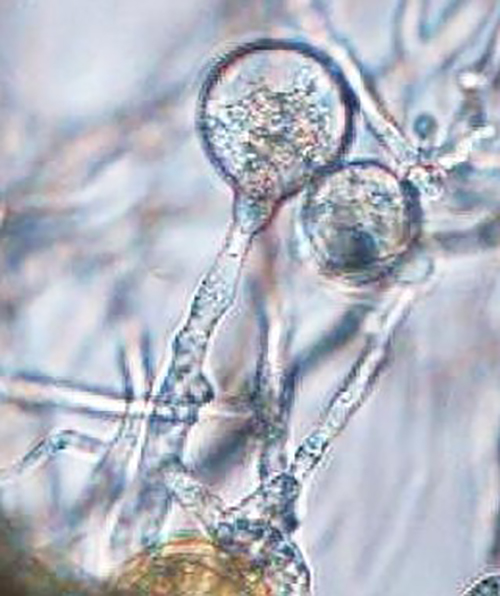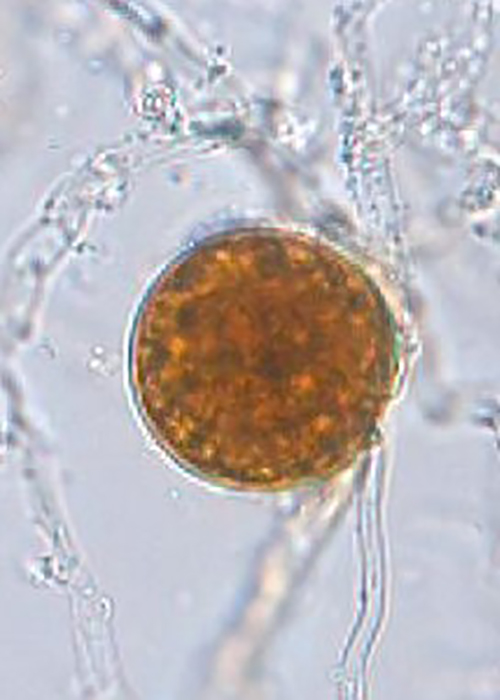Phytophthora fragariaefolia
|
Phytophthora spp. in subclade 7d: portion of the seven-loci ML phylogeny featuring the type cultures of 212 described species (by T. Bourret). Notice the position of P. fragariaefolia Ex-type CBS 135747 = S&T BL 141. Gloria Abad, USDA S&T.
|
|
Phytophthora spp. in subclade 7d: Morphological Tabular key (PDF) and Tabular key legends (PDF) in IDphy2 KEY SECTION. Notice the data of P. fragariaefolia Ex-type CBS 135747 = S&T BL 141. Gloria Abad, USDA S&T.
|
|
Phytophthora fragariaefolia (CPHST BL 141) colonies of the ex-type grown for 7 days on (a) V8® Agar, (b) potato dextrose agar, and (c) malt extract agar; photo by Krysta Jennings and Leandra Knight, USDA-APHIS-PPQ |
|
Phytophthora fragariaefolia (ex-type CH05NSU11) asexual phase: (a–e) nonpapillated persistent sporangia, (c, d) with internal and (e) external proliferation; (f, g) spherical and subspherical hyphal swellings; (h) spherical intercalary chlamydospore; photos by Mohamed Rahman and Koji Kageyama, Gifu University, Japan |
|
Phytophthora fragariaefolia (ex-type CH05NSU11) sexual phase: (a–d) smooth-walled oogonia with aplerotic oospores; (b) with paragynous antheridium and funnel-shaped oogonium; (c) amphigynous antheridium with finger-like projection; (d) amphigynous and paragynous antheridia; (e) distorted oogonium; photos by Mohamed Rahman and Koji Kageyama, Gifu University, Japan |
|
Phytophthora fragariaefolia (ex-type CPHST BL 141) asexual phase with nonpapillated persistent sporangia originated in unbranched sporangiophore; photo by Gloria Abad, USDA-APHIS-PPQ. |
|
Phytophthora fragariaefolia (ex-type CH05NSU11) asexual phase: spherical hyphal swellings; photo by Mohamed Rahman and Koji Kageyama, Gifu University, Japan. |
|
Phytophthora fragariaefolia (ex-type CH05NSU11) asexual phase: subspherical hyphal swelling; photo by Mohamed Rahman and Koji Kageyama, Gifu University, Japan. |
|
Phytophthora fragariaefolia (ex-type CH05NSU11) asexual phase: spherical intercalary chlamydospore; photo by Mohamed Rahman and Koji Kageyama, Gifu University, Japan. |
Name and publication
Phytophthora fragariaefolia M.Z. Rahman, S. Uematsu, Toru Takeuchi, K. Shirai & Kageyama (2014)
Rahman MZ, Uematsu S, Takeuchi T, Shirai K, Ishiguro Y, Suga H, and Kageyama K. 2014. Two new species, Phytophthora nagaii sp. nov. and P. fragariaefolia sp. nov., causing serious diseases on rose and strawberry plants, respectively, in Japan. J. Gen. Plant Pathol. 80: 348–365.
Corresponding author: rahman@green.gifu-u.ac.jp
Nomenclature
from Rahman et al. (2014)
Mycobank
Etymology
refers to generic name of the host plant, strawberry (Fragaria ananassa)
Typification
Type: JAPAN, Hokkaido Prefecture, from crown of strawberry (Fragaria ananassa), 2005, collector T. Takeuchi; isolate NBRC H-13133-holotypus (freeze-dried specimen)
Ex-type: NBRC 109709 = CBS 135747 (= CH05NSU11, MAFF 244058)
Sequences for ex-type in original manuscript
(ET) CBS 135747, NBRC 109709, CH05NSU11, MAFF 244058, WPC P19990, S&T BL 141 (Abad), 61H4 (Hong)
Ex-type in other collections
NBRC 109709 = CBS 135747 = P19990 (WOC/WPC), CPHST BL 141 (Abad), 61H4 (Yang)
Molecular identification
Voucher sequences for barcoding genes (ITS rDNA and COI) of the ex-type (see Molecular protocols page)
Phytophthora fragariaefolia isolate CPHST BL 141 (= P19990 WPC) = ITS rDNA MG865495, COI MH136891
Voucher sequences for Molecular Toolbox with seven genes (ITS, β-tub, COI, EF1α, HSP90, L10, and YPT1
(see Molecular protocols page) (In Progress)
Voucher sequences for Metabarcoding High-throughput Sequencing (HTS) Technologies [Molecular Operational Taxonomic Unit (MOTU)]
(see Molecular protocols page) (In Progress)
Sequences with multiple genes for ex-type in other sources
- NCBI: Phytophthora fragariaefolia CPHST BL 141
- NCBI: Phytophthora fragariaefolia CH05NSU11
- EPPO-Q-bank: Phytophthora fragariaefolia
- BOLDSYSTEMS: Phytophthora fragariaefolia (barcoding COI & ITS)
Position in multigenic phylogeny with 7 genes (ITS, β-tub, COI, EF1α, HSP90, L10, and YPT1)
Clade clade:
a taxonomic group of organisms classified together on the basis of homologous features traced to a common ancestor
7d
Morphological identification
adapted from Rahman et al. (2014)
Colonies and cardinal temperatures
Colony colony:
assemblage of hyphae which usually develops form a single source and grows in a coordinated way
morphology after 7 days on PDA, V-8, MEA, and HSA with no distinct pattern. Minimum growth temperature 5°C, optimum 28°C, and maximum 33°C.
Conditions for growth and sporulation
Sporangia formed in grass leaf blade water culture. OogoniaOogonia:
the female gametangium in which the oospore forms after fertilization by the antheridium
and oosporeoospore:
zygote or thick-walled spore that forms within the oogonium after fertilization by the antheridium; may be long-lived
abundantly produced in single culture.
Asexual phase
SporangiaSporangia:
sac within which zoospores form, especially when water is cooled to about 10°C below ambient temperature; in solid substrates, sporangia usually germinate by germ tubes
nonpapillatenonpapillate:
pertaining to the production of a non-distinct, or inconspicuous, papilla at the distal end of the sporangium (cf. papillate and semipapillate)
; persistentpersistent:
pertaining to sporangia that remain attached to the sporangiophore and do not separate or detach easily (cf. caducous)
; ellipsoidellipsoid:
refers to a solid body that forms an ellipse in the longitudinal plane and a circle in cross section; many fungal spores are ellipsoidal or elliptic
, spherical, distorted (28–59 L × 14–43 W μm); with internal (nested or extended) and external proliferationexternal proliferation:
formation of a sporangium after a sporangiophore has emerged from beneath and external to an empty sporangium that has previously emitted its zoospores (cf. internal proliferation)
; grown in unbranched and simple sympodial sporangiophores. Hyphal swellings globoseglobose:
having a rounded form resembling that of a sphere
and subglobose, terminal and intercalaryintercalary:
positioned within a hypha (cf. terminal)
. ChlamydosporesChlamydospores:
an asexual spore with a thickened inner wall that is delimited from the mycelium by a septum; may be terminal or intercalary, and survives for long periods in soil
globoseglobose:
having a rounded form resembling that of a sphere
intercalary (32 μm diam).
Sexual phase
Homothallic. OogoniaOogonia:
the female gametangium in which the oospore forms after fertilization by the antheridium
smooth, spherical (26–44 μm diam), sometimes funnel-shaped with tapering base; antheridiaantheridia:
the male gametangium; a multinucleate, swollen hyphal tip affixed firmly to the wall of the female gametangium (the oogonium)
predominantly paragynousparagynous:
pertaining to the sexual stage in which the antheridium is attached to the side of the oogonium (cf. amphigynous)
; spherical, globoseglobose:
having a rounded form resembling that of a sphere
, ellipsoidellipsoid:
refers to a solid body that forms an ellipse in the longitudinal plane and a circle in cross section; many fungal spores are ellipsoidal or elliptic
(13–27 L ×12–19 W μm); oospore oospore:
zygote or thick-walled spore that forms within the oogonium after fertilization by the antheridium; may be long-lived
aplerotic aplerotic:
pertaining to a mature oospore that does not fill the oogonium; i.e. there is room left between the oospore wall and oogonium wall (cf. plerotic)
(22–35 μm diam).
Additional specimen(s) evaluated
Phytophthora fragariaefolia ex-type CPHST BL 141, duplicate of P19990 (World Phytophthora Collection)
Hosts and distribution
Distribution: Asia (Japan), Europe (Poland)
Substrate: crowns, soil
Disease note: crown rot
Host: Fragaria x ananassa (Rosaceae), Fraxinus excelsior (Oleaceae)
Retrieved January 30, 2018 from U.S. National Fungus Collections Nomenclature Database.
Additional references and links
- SMML USDA-ARS: Phytophthora fragariaefolia
- EPPO Global Database: Phytophthora fragariaefolia
- Forest Phytophthoras of the world: Phytophthora fragariaefolia
- CABI Digital Library: Phytophthora fragariaefolia
- Encyclopedia of Life (EOL): Phytophthora fragariaefolia
- Index Fungorum (IF): Phytophthora fragariaefolia
- Google All Phytophthora fragariaefolia
- Google Images Phytophthora fragariaefolia
- Google Scholar Phytophthora fragariaefolia
Fact sheet author:
Z. Gloria Abad, Ph.D., USDA-APHIS-PPQ-S&T Plant Pathogen Confirmatory Diagnostics Laboratory (PPCDL), United States of America.


.jpg)



